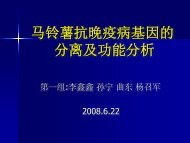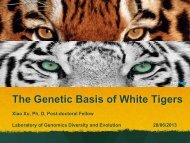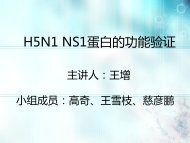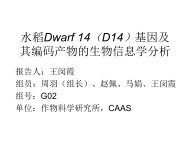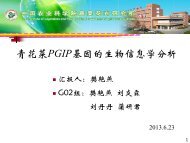Environmental connections of novel avian-origin H7N9 influenza ...
Environmental connections of novel avian-origin H7N9 influenza ...
Environmental connections of novel avian-origin H7N9 influenza ...
You also want an ePaper? Increase the reach of your titles
YUMPU automatically turns print PDFs into web optimized ePapers that Google loves.
Li J, et al. Sci China Life Sci June (2013) Vol.56 No.6 7Table 2 Variable amino acid residues in the HA, NA and PB2 proteins <strong>of</strong> <strong>H7N9</strong> viruses a)Protein b) Position Hangzhou/1 Hangzhou/2 Hangzhou/3 Env/HangzhouZhejiang/DTID- Chicken/ZJU01 ZhejiangShanghai/1 Shanghai/2 Anhui/1PB2 195 D E D D D D D D D197 K R K K K K K K K224 S T T T T T T T T292 V V V V V V V I V395 A A A A S A S A A461 I I I I I I V I I559 N T N N N N T N N627 c) K K K E E E K K K701 c) D D D D N D D D D740 D D A D D D D D DHA 42 V V V V V G V V V65 R R M R R K R R R72 C C C C C G C C C74 L L L L L P L L L75 L L L L L R L L L96 I I I I I M I I I146 A A A A A A S A A173 M I M M M M M M M183 S S S S S S N S S195 V V V V V V G V V230 P P P P P P T P P235 d) I L L L L Q Q L L285 N N N N N N D N N292 H H H H H H Y H H410 N N N N N N T N N541 V V V V V V A V VNA 26 I I I I I I M I40 G S G G G S G G294 e) R R R R R R K R R305 I I V I I I I I I345 N N I N N N N N N428 L L L L L V L L L439 W W W W L W W W W441 T T T T T A T T T442 S S S S G G S S S443 N N N N D N N N Na) The full names <strong>of</strong> the viruses are listed in the legend <strong>of</strong> Figure 2. b) Numbering <strong>of</strong> the protein sequences begins with the first ATG start codon (methionine).c) The E627K or D701N substitutions in the PB2 protein are critical for the adaptation <strong>of</strong> <strong>avian</strong> <strong>influenza</strong> A viruses to their mammalian hosts. Importantresidues discussed in the text are shaded gray. d) The Q235L mutation (Q226L in the H3 numbering system) increases the binding affinity <strong>of</strong> HA tothe human receptor. e) The R294K mutation (R292K in the N2 numbering system) in the NA protein confers resistance to oseltamivir.es have not been determined. This result may indicate thenecessity for an extensive surveillance to investigate theaccumulated effects <strong>of</strong> these virus substitutions on thepathogenesis <strong>of</strong> human.The pathogenesis <strong>of</strong> the <strong>novel</strong> <strong>avian</strong>-<strong>origin</strong> <strong>H7N9</strong> virusin humans remains unknown; however, a series <strong>of</strong> substitutionswere found in Hangzhou <strong>H7N9</strong> viruses which hadbeen determined previously to be related with infection andsevere diseases in animal models [12]. For example, thesubstitution at position 226 <strong>of</strong> the HA protein has been determinedas pivotal residue in the binding <strong>of</strong> <strong>avian</strong>- or human-typereceptor and, it has been suggested, that the presence<strong>of</strong> residue 226L might increase the airborne transmission<strong>of</strong> the virus [4,13]. The Q226L substitution in the HAprotein <strong>of</strong> H5 laboratory-mutated viruses was shown tocause the viruses to bind strongly to α-2,6 human-like receptors[5,14]. However, we observed a Q226I substitutionin the HA sequence from Hangzhou/1. Isoleucine and leucineare both hydrophobic residues which may imply thatthe Q226I mutation plays a similar major role in the α-2,6receptor binding and human adaption <strong>of</strong> some <strong>of</strong> the new<strong>H7N9</strong> viruses. Some <strong>of</strong> the sequences <strong>of</strong> the H3 subtype <strong>of</strong>human infected <strong>influenza</strong> viruses that we obtained from theInfluenza Virus Resource database [9] also contained theQ226I mutation. However, this is the first report <strong>of</strong> theQ226I substitution at this site for the H7 subtype (Figure 4),which may indicate a <strong>novel</strong> host adaption feature <strong>of</strong> the H7virus [12]. The receptor binding properties <strong>of</strong> HAs thatcontain the Q226I substitution need direct experimentalinvestigation.Previous studies indicated that several substitutions inPB2 sequences were associated with efficient virus replicationwhich contributed to the high pathogenicity <strong>of</strong> H5N1viruses in mice [68]. Two amino acid positions in the PB2




